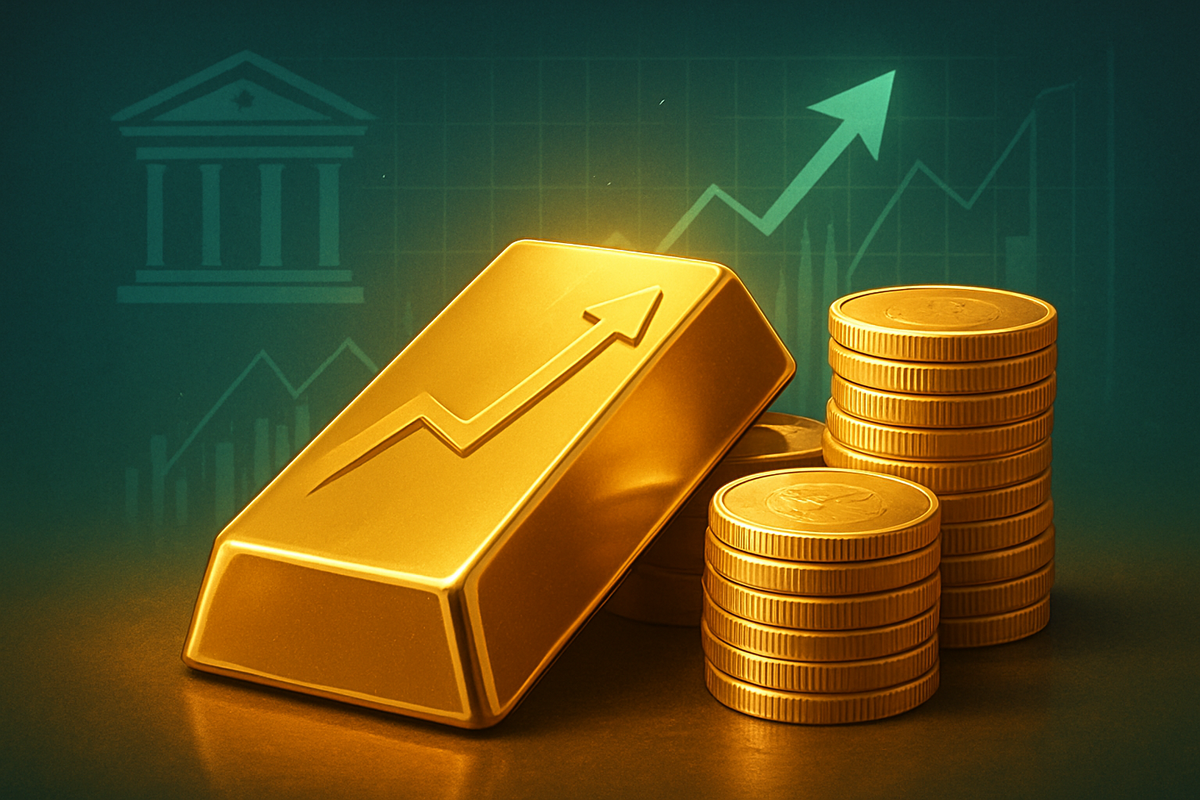
Gold has entered an unprecedented era, with prices surging past the $4,000 per ounce mark in a historic "golden rally" that has captivated global financial markets. This monumental ascent, which saw the precious metal establish new all-time highs, is primarily driven by mounting expectations of significant interest rate cuts from the U.S. Federal Reserve, coupled with persistent geopolitical tensions and robust central bank demand. The rally signifies a profound shift in investor sentiment, positioning gold as a cornerstone asset in an increasingly uncertain global economic landscape.
The immediate implications of this surge are far-reaching, sparking renewed interest in precious metals and prompting a re-evaluation of portfolio strategies among institutional and retail investors alike. While the market has experienced some volatility, including a brief correction, gold’s swift rebound above $4,000 on October 29, 2025, underscores the strong underlying bullish sentiment and the metal's enhanced role as a safe-haven asset amidst inflationary pressures and economic headwinds.
The Unprecedented Ascent: A Detailed Account of Gold's Historic Surge
The year 2025 has etched itself into the annals of gold market history. The precious metal achieved a monumental milestone on Tuesday, October 7, 2025, when it first breached the $4,000 per ounce threshold, with futures trading around $4,005.80. This remarkable event followed a staggering year-to-date increase of over 50%, reflecting a powerful and sustained buying spree. The rally continued its impressive trajectory, culminating in an all-time high near $4,381 by October 20, 2025, specifically peaking at $4,379.13 on October 17, 2025.
However, the path to these historic highs was not without its undulations. Following its mid-October peak, gold experienced a sharp, albeit temporary, correction. Prices dipped below $4,000 for the first time in October, hitting around $3,963.53 on October 28, 2025, and briefly touching a three-week low near $3,886. Yet, the resilience of the market was evident as gold swiftly rebounded, reclaiming the $4,000 level by October 29, 2025, trading between $4,016 and $4,020 per ounce. This rapid recovery was largely attributed to "aggressive value buying" as investors seized the opportunity to buy the dip.
Key players and stakeholders have been instrumental in this market dynamic. The Federal Reserve stands at the forefront, with its monetary policy decisions heavily influencing gold's appeal. Market sentiment on October 29, 2025, indicated a nearly 75% probability of a 25-basis-point rate cut at the upcoming December meeting, according to the CME FedWatch Tool. This expectation was further solidified by anticipation of a second consecutive 25-basis-point rate cut, which would lower the target range to 3.75%-4.00%. Lower interest rates typically weaken the US dollar and reduce the opportunity cost of holding non-yielding assets like gold, making it more attractive. Furthermore, central banks, particularly those in emerging markets, have significantly ramped up their gold purchases as a strategic diversification move away from US assets and currency risk, providing a structural underpinning to demand. Initial market reactions included a weakening US dollar index (DXY) to its lowest in three weeks and falling 10-year US Treasury yields, both contributing to gold's upward momentum.
Corporate Fortunes: Winners and Losers in the Golden Era
The unprecedented surge in gold prices has created a clear delineation of winners and losers within the corporate landscape, particularly impacting companies directly involved in the precious metals sector.
Gold mining companies are undoubtedly among the primary beneficiaries. Firms like Barrick Gold (NYSE: GOLD) and Newmont (NYSE: NEM) are poised to see substantial increases in their revenues and profitability as the value of their primary product skyrockets. Higher gold prices translate directly into fatter profit margins, enabling these companies to potentially expand exploration budgets, invest in new projects, increase dividends for shareholders, and see their stock prices appreciate significantly. The sustained high price environment could also spur consolidation within the mining industry as larger players seek to acquire smaller, resource-rich operations.
Conversely, the impact on jewelry retailers can be mixed. While a higher perceived value of gold might boost demand for luxury items, the increased cost of raw materials could squeeze profit margins for jewelers, especially those operating on tighter cost controls. Companies like Tiffany & Co. (NYSE: TIF) or Signet Jewelers (NYSE: SIG) will need to carefully manage their inventory and pricing strategies to balance higher input costs with consumer demand. Furthermore, industries that rely on stable commodity prices or those negatively impacted by inflation concerns could face headwinds. Any company with significant exposure to a weakening US dollar, as is often the case when gold rallies on rate cut expectations, might also see adverse effects on their international earnings. Investment vehicles like SPDR Gold Shares (NYSE: GLD), which track gold prices, also stand to benefit immensely, offering investors a liquid way to participate in the rally.
Wider Significance: A Shift in Global Financial Dynamics
The "golden rally" is far more than just a commodity price spike; it represents a significant shift in broader industry trends and global financial dynamics. This event underscores a growing disillusionment with traditional safe havens, such as government bonds, particularly in an environment of unprecedented monetary easing and increasing national debt. Gold, with its millennia-long history as a store of value, is reasserting its role as the ultimate hedge against economic instability and currency devaluation.
The ripple effects of gold's ascent are manifold. It could intensify the de-dollarization efforts by central banks, especially those in emerging markets, which are increasingly diversifying their reserves away from the US dollar and into gold. This trend, already evident, gains further momentum as gold demonstrates its resilience and appreciation. The rally also has implications for other precious metals, potentially pulling up prices for silver (NYSEARCA: SLV), platinum, and palladium, as investors seek alternative stores of value within the commodity complex. Furthermore, it influences global investment strategies, with a greater allocation towards hard assets and inflation hedges. Regulatory and policy implications are also significant; the Federal Reserve's future rate decisions will be paramount, and governments worldwide will be closely watching commodity inflation and its potential impact on consumer prices and economic stability. Historically, gold has surged during periods of high inflation or geopolitical uncertainty, such as the 1970s or the post-2008 financial crisis. However, the current rally, pushing prices above $4,000, sets a new precedent, reflecting a unique confluence of monetary policy expectations, safe-haven demand, and structural shifts in central bank reserve management.
What Comes Next: Navigating the Golden Horizon
As gold firmly establishes itself above the $4,000 mark, market participants are keenly looking ahead to what comes next for the precious metal. In the short term, continued volatility is to be expected. While the underlying bullish sentiment remains strong, periodic corrections like the one seen in late October 2025 are likely as investors take profits. The market will be closely scrutinizing every announcement from the Federal Reserve, particularly regarding the timing and magnitude of future rate cuts, which remain the primary catalyst for gold's upward trajectory. Geopolitical developments and global economic data will also play a crucial role in shaping near-term price movements.
Looking further out, the long-term outlook for gold appears exceptionally bright, according to leading financial institutions. Goldman Sachs Research projects gold prices to reach $4,000 per troy ounce by mid-2026, driven by robust structural demand from central banks and anticipated Federal Reserve easing. JPMorgan is even more optimistic, forecasting gold to hit $5,055 by late 2026 and potentially an astounding $8,000 by 2028, signaling a belief in a multi-year bull run. A Reuters survey of analysts and traders produced a median forecast of $4,275 for 2026, marking the first time analysts have collectively projected an average annual price above $4,000. These projections suggest that the current rally is not a fleeting phenomenon but potentially the beginning of a sustained upward trend.
These forecasts imply significant strategic pivots for investors and institutions. Diversification into gold and gold-related assets will likely continue to be a dominant theme. Central banks are expected to persist in their accumulation strategies, further underpinning demand. For gold mining companies, this sustained high-price environment presents opportunities for accelerated development of new projects and increased exploration efforts to capitalize on rising valuations. Emerging market economies might find opportunities to bolster their financial independence through increased gold reserves. However, challenges may arise for investors who missed the initial surge, as entry points become higher, necessitating careful risk assessment. Potential scenarios range from a steady climb fueled by consistent Fed easing to more volatile swings driven by unexpected economic or geopolitical events.
A Golden Standard: The Enduring Significance of Gold's Rally
The historic "golden rally" of 2025, with gold prices surging well past $4,000 per ounce, marks a pivotal moment in financial markets. It underscores gold's enduring appeal as a safe-haven asset and its growing importance in a world grappling with economic uncertainty, inflationary pressures, and a shifting geopolitical landscape. The primary driver – the widespread expectation of Federal Reserve interest rate cuts – highlights the profound impact of monetary policy on commodity markets, while robust central bank demand provides a structural foundation for sustained growth.
Moving forward, gold is firmly re-established as a key component of diversified portfolios, a hedge against currency debasement, and a reliable store of value. The market has unequivocally signaled its confidence in gold's ability to protect wealth in turbulent times. The breach of the $4,000 mark is not merely a numerical achievement; it represents a psychological and fundamental shift, resetting investor expectations and validating gold's role as a global monetary asset.
Investors should closely monitor several key indicators in the coming months. The Federal Reserve's actual rate decisions will be paramount, as any deviation from current expectations could introduce volatility. Inflation data, geopolitical developments, and the continued trend of central bank gold purchases will also be critical factors influencing gold's trajectory. As the global financial system continues to evolve, gold's luster appears set to shine even brighter, promising an intriguing and potentially rewarding journey for those who understand its enduring significance.
This content is intended for informational purposes only and is not financial advice





